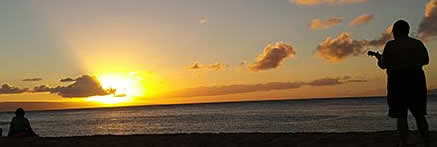Travel has many benefits. As Mark Twain said, it is "fatal to prejudice, bigotry and small mindedness." Travel shares another benefit of particular importance right now. It lingers in memory so that, when you can't travel, you can still recall great moments from great trips. During this time while we await the relief that vaccines may eventually offer, our store of memories, stimulated by the photos we took then, bring back the pleasures of that past. Here, for example and for your vicarious pleasure, are some highlights of our 2019 visit to Brazil's Rio de Janeiro.
| |
|
|
The image that says "Rio" world-wide is, of course, the Cristo Redentor - the Christ the Redeemer statue that tops Corcovado Mountain. It can be seen from almost anywhere in this city of nearly seven million Brazilians. That is, it can be seen when the weather is clear - as it was for our 2019 visit - but not when we first visited Brazil ten years earlier. |
|
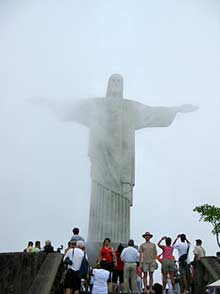 |
|
| |
Cristo Redentor Statue... |
|
|
|
...shrouded in fog |
|
Both times we took the cog train through the Corcovado mountainside's Tijuca National Park, claimed to be the largest urban forest in the world.
| |
|
|
|
|
| |
Train leaves the station for
the ride up Corcovado. |
|
The cog train travels through
Tijuca National Park |
|
Once on top, tourists congregate on the overlooks to snap shots not only up toward the statue, but down toward the city. Visible and shot-worthy are the South Zone where Copacabana and Ipanema beaches shimmer, and Sugarloaf Mountain, the 1,299-foot peak that marks the entrance to Guanabara Bay.
| |
|
|
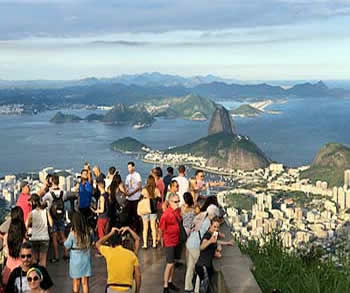 |
|
| |
At the overlook, the tourists
take photos up at the statue...
|
|
... and spot the sights below.
|
|
Easily spotted are other landmarks as well. There is the Rodrigo de Freitas Lagoon with Ipanema beyond. The lagoon is cut off from the Atlantic Ocean but fills with salt water through a canal. With almost a square mile of surface area, the lagoon attracts canoeists, rowers and crowds of bike riders around its shore.
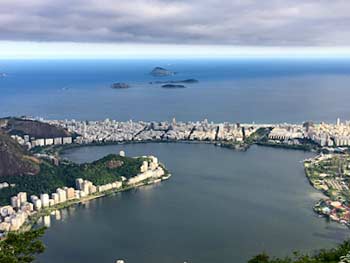
Ipanema separates the Rodrigo de Freitas Lagoon from the Atlantic Ocean.
There's the Hipodromo da Gavea racetrack where jockeys "sit right down on top of the horse" as Dr. Harold Hill tells us in The Music Man. Beyond the racetrack you can see Mirante do Morro Irmaos (The Two Brothers Mountain). The two peaks top out at 1,296 feet for the shorter one and a full 2,310 feet for the taller.
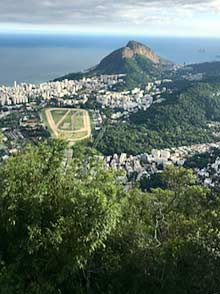
The Hipodromo da Gavea racetrack is easy to spot
with Mirante do Morro Irmaos beyond.
Of course, after the cog train ride back down Corcovado, you can head over to Sugarloaf itself to ride the cable car up to its peak. The cableway operates in two sections. The first takes you up to just over 700 feet in elevation with a cable sling of nearly 2,000 feet. Then, the final ascent is even longer with a sling of a nearly 2,800 feet to rise to the very top.
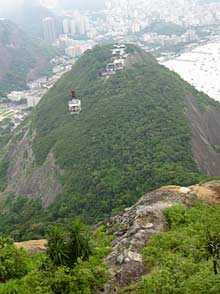
A cable car on its way up to the peak of Sugarloaf.
Sugarloaf may be the most famous local peak but it is not unique. Rio is home to several monolithic granite and quarts mountains known as bornhardts, named after a German geologist. From the beaches in Rio's South Zone you can see them to the east of Copacabana and to the west of Ipanema.
| |
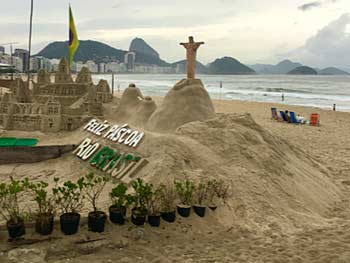 |
|
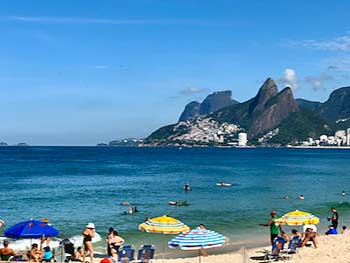 |
|
| |
Bornhardts dominate the horizon from the beach at Copacabana. |
|
Looking the other direction from Ipanema you can also see bornardts. |
|
Back in the downtown area you find a host of beautiful early twentieth century buildings including the Theatro Municipal (1909), Biblioteca Nacional (1910) and the Museu Nacional de Belas Artes (1937).
| |
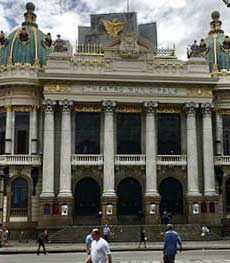 |
|
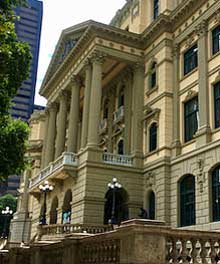 |
|
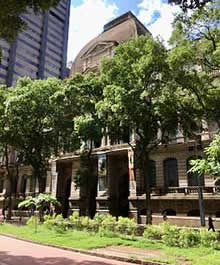 |
|
| |
The Theatre Municipal
built in 1909 |
|
The Biblioteca Nacional
built in 1910. |
|
The Museu Nacional de Belas Artes built in 1937. |
|
Each of these buildings has a name in Portuguese. That is because Brazil's national language is Portuguese as a consequence of its history as a colony of Portugal for over three hundred years beginning in 1500. In fact, between 1807 and 1821, Rio de Janeiro was the capital of Portugal after Queen Maria I and Prince Regent Joao moved their capitol here from Lisbon to escape Napoleon who was taking over nearly all of Europe.
Today you can still see the place where the royal family arrived on March 8, 1807, to take up residence in what was then called the Palace of the Viceroys, but instantly became the Royal Palace or Paco Real.
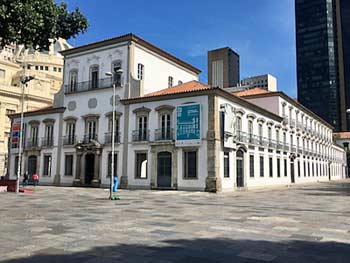
The Palace of the Viceroys became the Paco Real
when the Portuguese monarchs moved to Brazil.
That building has another claim to fame. It was the subject of the very first photograph ever taken in the Americas. That photo, taken in 1840, is on display in the museum within the palace.
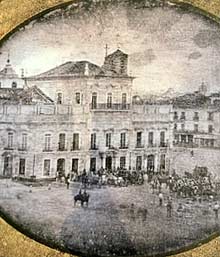
The Paco Real is the first photograph
ever taken in the Americas.
Next to the Paco Real today is the Palacio Tiradentes which was built in 1926 for the two houses of Brazil's national legislature, the Brazilian National Congress. When Brazil established its new capital city in Brazilia in 1960, the building was turned over to the state of Rio de Janeiro which now uses it as the headquarters of its unicameral Legislative Assembly. The building was named for the eighteenth-century revolutionary leader whose nickname was Tiradentes. His statue stands before the entrance.
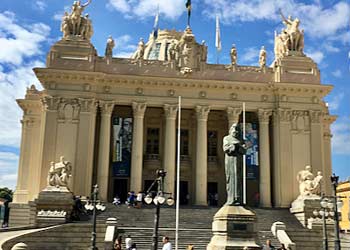
The statue of Tiradentes stands before the Palacio that bears his name.
On the other side of the Palacio Tiradentes stands a church. Its construction began as soon as the Royal family arrived in 1807, but wasn't completed until 1842. At this time, the crown had returned to Lisbon, when Brazil was independent with its own monarch, Pedro II. The late baroque style Igreja Sao Jose rang with music as I passed, so I entered to find crowds of worshipers at noon mass.
| |
|
|
|
|
| |
Igreja Sao Jose was completed in 1842. |
|
Worshipers fill the church at noon. |
|
Just across Praca XV or Praca Quinze de Novembro, named for the date of the proclamation of the Republic of Brazil, stands a most ornate ferry terminal.
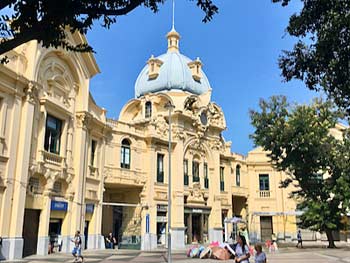
The ornate ferry terminal at Praca XV.
One of the more delightful remnants of the presence of the Portuguese court in Rio is the Botanical Garden. The Garden was founded by Dom when he and Queen Maria I first arrived and found the smell of the populated area around the port where the Paco Real was located quite disgusting. He spent many of his days enjoying the fresh air of what became a huge botanical garden of almost 350 acres containing more than 6,000 different species of plants and trees. Water plays a big part in the layout of the garden with cascades, lily ponds and even a turtle community with its own fountain.
| |
|
|
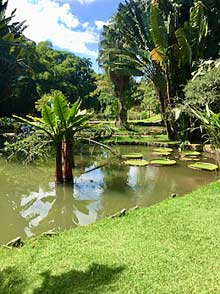 |
|
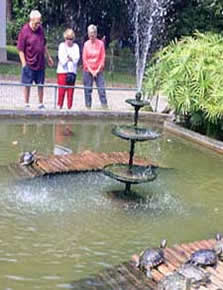 |
|
| |
Water flows down a cascade in the Botanical Garden.
|
|
Water is still in the lily ponds.
|
|
Some turtles swim in the water as others sun themselves. |
|
The trees of the garden are filled with local monkeys like this one who seemed to be guarding the entrance to the Orchid House.
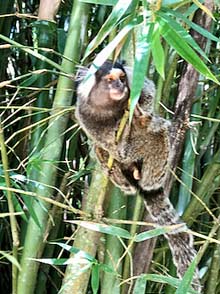
This monkey watches tourists entering the Orchid House.
In the center of the Orchid House, an island floats in a moat that contributes to the humidity in which the blooms blossom.
| |
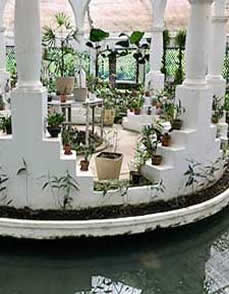 |
|
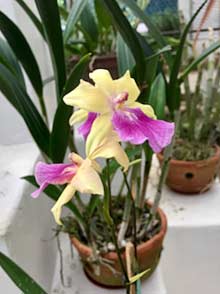 |
|
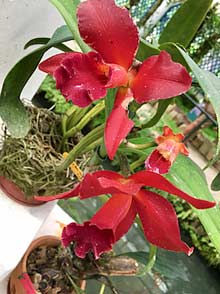 |
|
| |
The Orchid House in the Botanical Garden. |
|
Resident orchid
|
|
Red orchid in the orchid house. |
|
Another holdover from the Portuguese period can be found under your feet as you tour the beach-front sidewalks of Ipanema and Copacabana, the public parks and the squares of the city centers. The pavement is often calcada a portuguesa or Portuguese Pavement. Often you will find wavy patterns made of white and black paving stones.
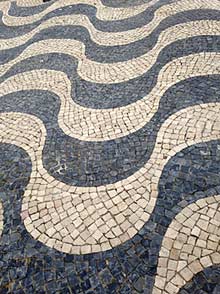
Typical pattern in calcada a portuguesa.
But keep looking and you will find much more variety ranging from geometric patterns to elaborate designs and even a dome of Neptune, god of the sea. So, I'll leave you with a few artistic samples.
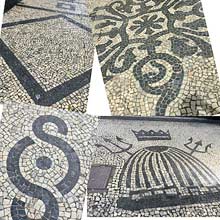
Some of the patterns of Rio's walkways.
| |
Brad Hathaway retired to live with his wife on a houseboat in Sausalito, California, after nearly two decades covering theater in Washington, D.C., on Broadway, and nationwide. He is past vice chair of the American Theatre Critics Association's Executive Committee. |
|
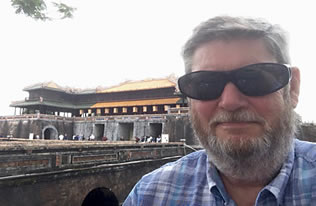 |
|
|
